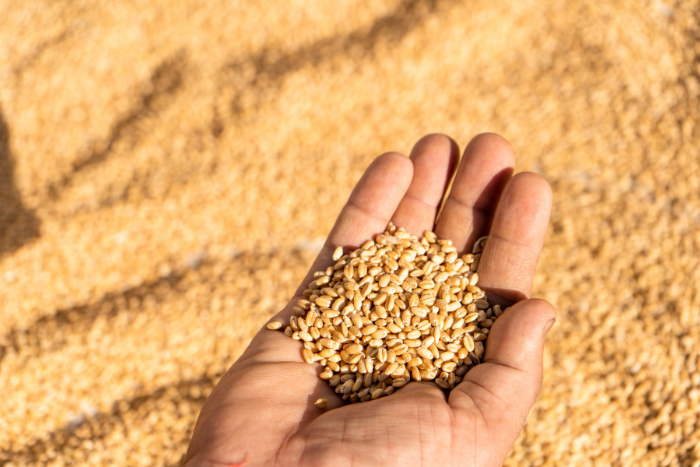India’s wheat crop is at risk. The country is set to see above-average temperatures in February, with key wheat- and rapeseed-growing states likely to see maximum temperatures up to 5°C above average on some days, Reuters reported, citing two weather bureau sources.
The newswire said India is counting on a bumper harvest in 2025 to avoid costly imports, following three straight years of poor crop yields since 2022. The report explained that after a sharp, sudden rise in temperatures in February and March shrivelled the crop, India was forced to ban exports of the staple in 2022.
Higher temperatures during the grain formation stage could reduce yields for the fourth straight year, trimming overall production and forcing authorities to lower or remove the 40% import tax to facilitate imports to tide over shortages., the report said.
Sikkim’s ‘Catastrophic’ 2023 lake outburst was driven by glacial melt and permafrost thaw: Study
A new study has attributed the “catastrophic” 2023 floods in the Himalayan state of Sikkim in India to climate change, Carbonbrief reported citing a study published in Science.
The outlet said the breach of one of the “largest, fastest-growing and most hazardous” glacial lakes in Sikkim, the South Lhonak lake, led to cascading floods that killed 55 people and washed away a 1,200 megawatt (MW) hydropower dam. The event was identified as a glacial lake outburst flood (GLOF), which is a sudden release of water from a lake fed by glacial melt. The research, published in Science, explores the many drivers of the GLOF, its extensive impacts and policy implications going forward.
Met Office: Atmospheric CO2 exceeds IPCC 1.5C development limits
The 1.5°C pathways to limit global warming set up by IPCC has now been breached considering the current rate of increase of atmospheric CO2, according to the Met Office, Carbonbrief reported.
This is what the latest data shows from the Mauna Loa observatory in Hawaii, where measurements of CO2 levels in the atmosphere have been collected for more than 60 years, the report said adding that the year 2024 witnessed one of the fastest rise of atmospheric CO2 on record.
CO2 emissions and other greenhouse gases from human activity have so far caused global warming to reach about 1.3C above pre-industrial levels. If warming is to be limited to 1.5°C, as set out in the Paris Agreement, the build-up of CO2 and other greenhouse gases in the atmosphere will need to slow to a halt and then go into reverse. And, yet, the rise in atmospheric CO2 concentrations is still showing no signs of slowing.
Marshall Islands announces first-ever marine sanctuary
The Pacific island nation of the Marshall Islands announced its first-ever marine protected area (MPA), Oceanographic Magazine reported. The marine sanctuary will cover 48,000 square kilometres of “the most pristine ecosystems in the Pacific Ocean”, said National Geographic Pristine Seas, an initiative focused on ocean conservation that helped provide the scientific basis for establishing the MPA. The report said the area will “be fully protected from fishing” and will be managed with “special emphasis on traditional knowledge and Indigenous insights”.
Heat stress destroys 44% corals in catastrophic bleaching event in southern Great Barrier Reef
Heat stress in May 2024 caused “catastrophic coral bleaching” in southern Great Barrier Reef (GBR) with a staggering 44% mortality rate in protected areas, in one of the largest bleaching events recorded, reported DTE.
This was the fourth global mass coral bleaching event (GCBE4) caused by heat stress which began in January 2023. The report said GCBE4 surpassed the 2014-2017 bleaching levels, with 77% of global reefs experiencing heat-induced stress, pushing the GBR into its fifth-largest widespread bleaching event, the report said.
The outlet pointed out that corals are vital to marine ecosystems, providing habitat for diverse species, food food security for coastal populations, and economic value through tourism. The report explained that coral bleaching occurs when corals expel the symbiotic algae, zooxanthellae, living within their tissues in response to heat stress, causing the corals to turn white. Prolonged stress or rapid changes can lead to death.
‘Multi-year’ droughts increasing, getting drier and hotter over past 40 years
New study published in Science has found that droughts spanning multiple years have become drier, hotter and more frequent over the past 40 years, Carbon Brief reported.
The study revealed that the global land surface affected by these extreme events has expanded at a rate of nearly 50,000 square kilometres (km2) per year in the past four decades – an area larger than Switzerland each year.
The article explained that multi-year droughts can cause significant declines in vegetation in ecosystems such as grasslands. These impacts can also translate into severe impacts for humans, including water scarcity.
About The Author
You may also like
Fog grips North India as cold wave spreads across central and southern states
Rains Lash South India as Early Cold Wave Grips Central and Northern India
India launches National Red List Assessment to map extinction risks of 11,000 species
At least 10 dead in heavy rain in Maharashtra, Mumbai crosses 3000 mm threshold
Extremely heavy rain flood Punjab, over hundred killed, 2.5 million forced to flee

